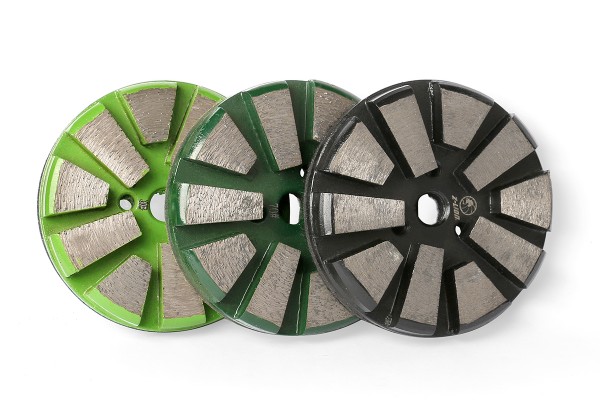Is dry grinding or wet grinding better for concrete floors?
When sanding concrete floors, the decision between wet and dry methods is a key consideration that can significantly affect the outcome of the project. The choice between wet and dry sanding is influenced by a variety of factors, including the condition of the concrete floor, the environmental setting, the desired final appearance, and other specific preferences. Understanding the benefits and considerations of each approach is critical to making informed decisions that meet the unique requirements of your project.
In many cases, a combination of dry and wet sanding is considered the most effective method of sanding concrete floors. This hybrid approach leverages the best of both technologies, resulting in a comprehensive and high-quality sanding process. By combining dry and wet sanding, dust generation can be minimized while improving the overall quality of the surface finish.
One of the key considerations in the wet versus dry grinding debate is the environmental impact of each method. Dry grinding is often favored for its ability to solve processing problems, as managing the slurry produced during wet grinding can pose challenges. Proper disposal of cement mortar slurry is subject to regional regulations, and contractors must research and follow specific guidelines for slurry disposal in their area. Additionally, the use of wet vacuum systems is critical to effective slurry management, and contractors may choose to invest in or lease this equipment to ensure compliance with environmental regulations.
The environmental impact of wet grinding should also be carefully considered, particularly about water and wastewater management. While wet grinding can minimize dust and airborne particles, it requires the use of water, which can result in the production of wastewater. Proper water harvesting and wastewater treatment measures are essential to mitigate the environmental impact of wet milling, ensuring water use is managed responsibly and in compliance with environmental regulations.
When sanding and polishing concrete floors, the choice of wet or dry methods is a key consideration that affects worker health and safety and the cleanliness of the work environment. Understanding the benefits and potential risks associated with each method is critical to making informed decisions that prioritize worker well-being and the overall quality of the project.
Wet sanding and polishing concrete floors offer several advantages, especially when it comes to dust control. This method effectively eliminates the dust cloud generated during the dry grinding process, creating a cleaner and safer working environment. Even with large dust collectors, workers can still be exposed to large amounts of dust when dry grinding concrete. In contrast, wet grinding minimizes airborne particles, reducing the risk of inhalation and promoting a healthier work environment.
To further improve worker safety, it is critical to provide workers with protective masks and other personal protective equipment during the dry grinding process. Appropriate instruction and training on the use of protective masks should be provided and workers should be encouraged to wear masks at all times during dry grinding activities. Additionally, extreme caution should be used in retail settings and in work areas near customers or other workers. Dust generated during the dry grinding process in retail locations should be promptly cleaned up at the end of each day to prevent contamination of merchandise and maintain a clean and safe environment for customers and workers.
In addition to health and safety considerations, the cleanliness of the work environment is a key factor to consider when choosing between wet and dry sanding concrete floors. Wet sanding minimizes the accumulation of dust and airborne particles, resulting in a cleaner work environment and reducing the need for extensive cleanup at the end of each day. This is especially important in retail and commercial environments, where maintaining a clean, aesthetically pleasing environment is critical to customer satisfaction and safety.
Wet sanding and polishing of concrete floors can significantly extend the life of diamond tools, especially on medium to very-hard floors. This method allows for more aggressive grinding and is particularly effective when removing large amounts of concrete to expose aggregate. Wet sanding enables diamond concrete grinding discs to cut faster on moderately and very hard floors, making it an effective option for floor builders seeking to achieve specific aggregate exposure levels. By creating more friction and keeping diamond tools cool, wet grinding prevents premature polishing of metal-bonded tools, ensuring a consistent, high-quality finish.
Additionally, wet grinding is beneficial in removing scratches left by metal grinding pads, especially during the initial stages of the polishing process. Using water in the first two to three steps of polishing can effectively remove scratches and leave a smoother, more refined surface. Additionally, higher roughness wet sanding may result in a duller surface, which is easier to maintain and may be preferred for some applications.

Dry sanding, on the other hand, is known for providing a much higher shine than wet sanding, giving the floor enhanced light reflection and a classic look. This method is particularly effective for achieving a glossy finish and is often favored for its ability to create a visually striking polished surface. It is important to note, however, that dry grinding is more suitable for soft cement floors, as using this method on harder surfaces can cause excessive wear on the diamond tools, resulting in increased costs and reduced profitability.
When dry polishing on hard cement floors, the diamonds may erode excessively and leave cut marks on the floor, resulting in poor results and possible rework. Therefore, when choosing between wet and dry grinding, careful consideration must be given to the type and hardness of the concrete to ensure that the chosen method meets the specific requirements of the project.
-
Online service
-
Official wechat account

-
QQ:40933769
-
E-mail:sales@z-lion.com
Online Message
Please feel free to give your inquiry in the form below. We will reply you in 24 hours.

